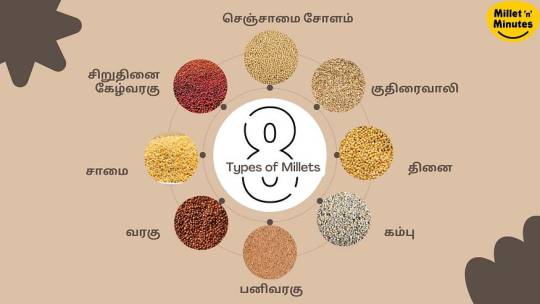#Varagu / kodo millet is a highly nutritious and versatile grain that can be used in a variety of dishes
Explore tagged Tumblr posts
Text
Kodo Millet Noodles
GOOD DIGESTION: The fiber-rich quality of kodo millet makes it easy to digest and it boosts the strength of your digestive system.
FULL OF NUTRIENTS: The millet noodles have essential vitamins and minerals that contribute to good health.
GOOD SOURCE OF IRON: The kodo millet noodles have folic acid content that improves blood health and keeps you strong.
#Varagu / kodo millet is a highly nutritious and versatile grain that can be used in a variety of dishes#from vayal foods breakfast porridges to savory dinners. This Kodo millet/ varagu is gluten-free grain is rich in fiber#protein#and essential minerals#vayal foods making it an excellent choice for anyone looking to improve their diet
0 notes
Text
Why Millets?

Millets have been a staple food for centuries, particularly in Asia and Africa. But recently, these tiny powerhouses have been gaining popularity worldwide. Why? Millets offer a unique combination of health benefits, environmental advantages, and culinary versatility. This beginner’s guide will explore the wonders of millets, from their nutritional value to their role in promoting food security.
Unveiling the Millet Family: A Diverse Bunch
First things first, what exactly are millets? Millets are a group of small-seeded cereal grains that belong to the Poaceae grass family. There are several types of millets, each with its own distinct flavor and nutritional profile. Some popular varieties include:
Foxtail millet (thinai): Known for its fluffy texture and slightly sweet taste.
Finger millet (kelvaragu): Rich in calcium and dietary fiber.
Pearl millet(kambu) : A good source of protein and iron.
Kodo millet(varagu): Highly digestible and gluten-free.
Proso millet(panivaragu): Often used in breakfast porridges due to its quick cooking time.
Despite their diversity, millets share some common characteristics. They are generally high in protein, fiber, and essential minerals. Additionally, millets are known for their drought tolerance and minimal water requirements, making them ideal crops for regions facing water scarcity.
Millets for a Healthy You: A Nutritional Powerhouse
Millets are a fantastic addition to a balanced diet. Here’s what makes them so good for you:
Rich in Fiber: Millets are a great source of dietary fiber, which promotes gut health, supports digestion, and can aid in weight management.
Gluten-Free: Millets are naturally gluten-free, making them a perfect choice for individuals with celiac disease or gluten sensitivity.
Packed with Minerals: Millets are a rich source of essential minerals like magnesium, phosphorus, potassium, and iron, all crucial for various bodily functions.
Low Glycemic Index: Most millets have a low glycemic index (GI), meaning they release sugar slowly into the bloodstream, which helps regulate blood sugar levels and may benefit those with diabetes.
Powerhouse of Antioxidants: Millets contain antioxidants that protect cells from damage and may reduce the risk of chronic diseases.
Millets and Food Security: A Sustainable Solution
Millets play a vital role in ensuring global food security. Here’s how:
Climate-Resilient: Millets are incredibly drought-tolerant and require minimal water to grow, making them ideal for cultivation in arid and unpredictable climates.
Shorter Growing Season: Compared to other cereals, millets have a shorter growing season, allowing for multiple harvests in a year, contributing to food security.
Minimal Resource Requirements: Millets require less fertilizer and pesticides compared to other staple crops, making them an environmentally friendly and sustainable food source.
By promoting millet cultivation, we can ensure a more resilient food system, particularly in regions vulnerable to climate change and food shortages.
Cooking with Millets: A Culinary Adventure
Millets are incredibly versatile grains and can be incorporated into various dishes. Here are some ideas to get you started:
Breakfast: Porridge made with millet flakes, nuts, and fruits.
Lunch: Millet salad with roasted vegetables and a light vinaigrette.
Dinner: Millet pilaf with spices and herbs.
Snacks: Millet puffs or bars for a healthy and satisfying snack.
Desserts: Millet kheer (rice pudding) for a nutritious and delicious sweet treat.
The possibilities are endless! Explore different types of millets, experiment with spices and flavors, and discover your favorite ways to enjoy these ancient grains.
Millet n Minutes in Madurai? Explore Local Delights!
For those looking to delve deeper into the world of millets, consider a visit to Madurai, a South Indian city known for its vibrant culinary scene and rich millet tradition. You can find a variety of delicious millet-based dishes, from savory upma (a semolina porridge) to sweet appams (pancakes).
Exploring local markets and restaurants in Madurai is a fantastic way to experience the culinary heritage of millets firsthand.
#desserts#food#foodgasm#foodblogger#foodlover#dessert#delicious#foodie#foodiesofinstagram#foodphotography
0 notes